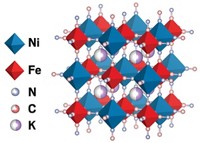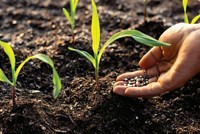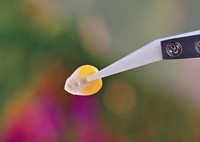Advertisement
Grab your lab coat. Let's get started
Welcome!
Welcome!
Create an account below to get 6 C&EN articles per month, receive newsletters and more - all free.
It seems this is your first time logging in online. Please enter the following information to continue.
As an ACS member you automatically get access to this site. All we need is few more details to create your reading experience.
Not you? Sign in with a different account.
Not you? Sign in with a different account.
ERROR 1
ERROR 1
ERROR 2
ERROR 2
ERROR 2
ERROR 2
ERROR 2
Password and Confirm password must match.
If you have an ACS member number, please enter it here so we can link this account to your membership. (optional)
ERROR 2
ACS values your privacy. By submitting your information, you are gaining access to C&EN and subscribing to our weekly newsletter. We use the information you provide to make your reading experience better, and we will never sell your data to third party members.
Business
Movers And Shakers
C&EN profiles Plant-e, a start-up looking to soil for power
Dutch university spin-off seeks to capture electrons from microbes living alongside plant roots
by Alex Scott
April 18, 2016
| A version of this story appeared in
Volume 94, Issue 16

Plant-e, a Dutch company spun off in 2010 from Wageningen University, has a vision that one day the rhizosphere, or soil root zone, won’t just provide plants with water and nutrients. It will provide people with electricity.
Plant-e at a glance
Headquarters: Wageningen, the Netherlands
Company focus: Technology for generating electricity from soil microbes
Funding: A few hundred thousand dollars, mostly from academic grants
Employees: Five
Legal status: Plant-e is an independent, privately held company
To some, the idea will seem implausible. But Plant-e, with a staff of just five, has already proven the concept with a demonstration project that powers LED safety lights on a road barrier. With refinements, the company hopes to develop a system cheap enough for small farmers in developing countries to generate their own electricity.
The idea came from founder David Strik, assistant professor of biology at Wageningen, whose expertise includes microbial fuel cells, and the company’s chief executive officer, Marjolein Helder, whose Ph.D. was on generating electricity from plants.
The electricity that Plant-e seeks to harvest is generated in tiny amounts in the rhizosphere by microbes of the Geobacter and Shewanella genera. These microbes, which thrive in wet, anaerobic conditions, consume organic matter released by plant roots and then jettison electrons into the soil.
“We provide the electron acceptor,” says Pim de Jager, Plant-e’s engineer, who works on the project in labs rented from the university.
The latest version of the firm’s technology is an anode tube about 5 cm wide and up to several meters long made mostly from an activated carbon-based felt. The cathode is inserted inside.
The system is buried in the soil, leaving crops to be planted and harvested as usual. “No one will notice anything apart from a couple of wires,” de Jager says.
Micropores on the surface of the activated carbon are large enough for the soil microbes to grow in. The bacteria grow “nanowires” inside the pores that connect with the activated carbon and enable the bacteria to release electrons to the anode.
The firm’s long-term goal is for 1 m2 of soil to yield 3 W of power, up from the 1 W it is currently generating in the lab. At this higher rate, about 125 m2 of suitable land could power an average family home in the Netherlands.
The company still has a way to go. A system Plant-e installed near Wageningen in November 2014 successfully powers LED warning lights on a road barrier. Based on an older modular technology, it only generates a “couple of watts” from a soil area of 100 m2, de Jager acknowledges. And each 1-meter tube currently generates just milliwatts of power.
The firm’s progress is encouraging, argues Jason He, an associate professor at Virginia Tech, whose own research includes using microbes both to decontaminate wastewater and harvest energy from it. One challenge is that ion movement is greatly limited, He says, resulting in an insufficient supply of electrons and subsequent limited electricity generation.
Plant-e is confident that better materials and a greater understanding of soil conditions will lead to significant increases in power output.
A future research focus will be determining optimal pore size on the anode surface. If the pores are too small, the firm thinks, the microbes may not be able to fit their nanowires inside them. The firm plans to investigate the use of carbon grains and graphite in place of the activated carbon felt in case their pore sizes are a better fit for the bacteria. “Whatever it is, it has to be cheap,” de Jager says.
To better understand how to improve the technology, late last year the firm began testing 30 variously configured systems in a waterlogged, western region of the Netherlands. The electron-harvesting tubes are between 1 and 2 meters in length. In a second trial, the tubes will be about 15 meters long.
In addition to generating electricity, Plant-e’s technology could promote the growth of electricity-generating soil bacteria at the expense of methanogens, bacteria that excrete the potent greenhouse gas methane. About 25% of global methane emissions are emitted by methanogens in rice paddies. Curbing such emissions could be eligible for payments from United Nations carbon reduction schemes. “If we can put a value on that, it’s a whole different ball game,” de Jager says.
Much of Plant-e’s funding, totaling just a few hundred thousand dollars, is from academic research grants. The firm has opted to take this route and maintain full control rather than recruit outside investors to accelerate its research. In the past few years, according to de Jager, it has rejected a number of advances from private investors and venture capitalists.
It might take some time before a commercially viable product is ready, but Plant-e is convinced it will be worth the wait. “It could provide farmers with power in some of the poorest regions of the world and even provide them with income,” de Jager says.





Join the conversation
Contact the reporter
Submit a Letter to the Editor for publication
Engage with us on Twitter